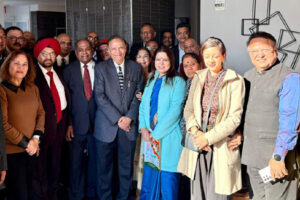Factories fall silent in Tiruppur
A tense stillness has settled over N Krishnamurthy’s garment factory in Tiruppur, one of India’s biggest textile export hubs.
Out of nearly 200 sewing machines, only a few remain in use, completing the final shipment of children’s wear for major US retail chains. In one corner, fabric swatches for future collections lie untouched – casualties of President Donald Trump’s decision to impose steep 50% tariffs on Indian exports, effective this week.
India, a leading supplier of garments, jewellery and seafood to the US, now faces what trade experts describe as “a near-ban” on its goods.
Export orders vanish overnight
Tiruppur accounts for a third of India’s $16bn ready-to-wear exports to brands such as Walmart, Target, Zara and Gap. But the mood here is one of despair.
“After September, we may not have any work left,” Krishnamurthy admits. New orders have dried up, his expansion plans are frozen, and 250 new recruits are on hold.
At another local factory, $1m worth of underwear meant for the US is lying idle. “We relied on a trade agreement. But shipments stopped abruptly last month. If this continues, how will I pay my staff?” asked Siva Subramaniam of Raft Garments.
Losing out to rivals
The tariffs have left Indian exporters struggling to compete.
A shirt that once sold for $10 in the US will now cost $16.40 after duties – far higher than alternatives from China ($14.20), Bangladesh ($13.20), and Vietnam ($12).
Even if tariffs are lowered to 25%, India would remain less competitive than its Asian rivals.
The government has suspended import duties on raw materials and accelerated trade talks with other nations, but experts warn buyers are likely to divert orders elsewhere.
Diamond polishers under pressure
In Mumbai’s export processing zone, workers continue polishing diamonds, but uncertainty looms. India ships nearly $10bn worth of gems and jewellery annually to the US, $3–4bn of which during September–October alone.
Margins in the industry are wafer-thin at just 3–4%. “Even an extra 10% duty is unbearable. Who can absorb this? Not even US retailers,” said Adil Kotwal of Creation Jewellery, which sends 90% of its diamond-studded ornaments to America.
In Surat, the global hub for diamond cutting and polishing, the crisis has deepened. Factories that once employed millions are now running at half-capacity.
Unit owner Shailesh Mangukia has cut his workforce from 300 to 70, while monthly production has plunged from 2,000 polished stones to barely 300.
Shrimp farmers in deep waters
Seafood exporters are also reeling. The US, a major buyer of Indian shrimps, has slapped duties above 60%. Prices have already fallen by $0.60–0.72 per kilo, with further declines expected.
“This is our busiest season for Christmas and New Year orders. But now farmers don’t know whether to even continue production,” said exporter Thota Jagadeesh.
Hatcheries are scaling back output. “We used to produce 100m shrimp larvae a year. Now we barely manage 60–70m,” said MS Varma of Srimannarayana Hatcheries in Andhra Pradesh.
Industry bodies warn the livelihoods of half a million shrimp farmers – and another 2.5m workers indirectly linked to the sector – are at stake.
Strained trade ties
India’s broader trade relationship with Washington has also taken a hit. A scheduled round of talks in Delhi was reportedly canceled, with US officials accusing New Delhi of “cosying up” to China and Russia.
“The future of India-US trade ties now depends on Trump’s domestic priorities and his stance on Russia and China,” said Gopal Nadadur of The Asia Group consultancy.
Searching for a way forward
For now, industries across India are being forced to adapt. Some are shifting focus to the domestic market and the upcoming Diwali season. Others are lobbying the government for relief measures.
But for many, survival looks uncertain.
“This place was once buzzing with workers,” said a diamond polisher in Surat, looking around an empty workshop. “Now, we don’t know what tomorrow will bring.”










